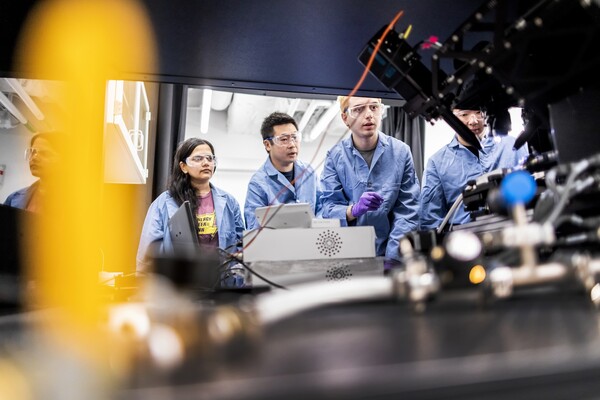
nocred

As a young graduate student at Harvard, Liliane Weissberg, the Christopher H. Browne Distinguished Professor in the School of Arts & Sciences, recalls combing through an enormous library of works, stunned by the vastness of it all. Coming from Europe, she was acutely aware that many collections had been lost or destroyed during World War II. What came to mind, then and now, are observations by German-Jewish philosopher Walter Benjamin, who in the 1935 essay “The Work of Art in an Age of Mechanical Reproduction” wrote about the “aura” of an artifact.
“He talked about the ‘aura’ of a singular object,” Weissberg says. “I think that during my graduate studies I was very much taken by that.”
This spring semester, she’s teaching the brand-new Inside the Archive course, instructing graduate students about the theory behind archives and combining that with excursions to local archives, plus some outside of Philadelphia—even international—through Zoom. The broader idea is to inspire and educate the next generation of scholars who will work with, and perhaps for, archives.
Weissberg’s own research frequently involves archival studies. She’s reconstructed texts, examined manuscripts, and recently published a German-language book, “Benjamin Veitel Ephraim Kaufmann, Schriftsteller, Geheimagent: Gesammelte Schriften,” about a Jewish spy during the French Revolution in Paris. That project took her through several archives, including a Prussian state archive that contains formerly unavailable materials from the 18th century, written in German, French—and penned in secret code. She’s also worked for the German Literature Archives in Marbach, Germany, where she ran summer courses for doctoral students and worked with curators and archivists on exhibits and publications.
“But to contextualize all this,” she explains, “is that Penn is particularly friendly toward connecting and working with libraries and archives in the classroom … And so, I felt this would be a good opportunity to invent a new course that is introducing our graduate students not only to work in the archives, but also to questions of what an archive means—historically and theoretically.”
In regard to archival theory, the course, which has 14 students enrolled, grapples with the work of many French philosophers, including Michel Foucault and Jacques Derrida. In question are fundamentals of the archive: How is history written? How is it preserved? Who owns it and what are the ethics associated with that? Who can access it?
Truly, the list goes on—all the way to modern problems of how to preserve using current technology.
“Part of what we are also talking about is the digitalization of archives, and that is very important right now,” Weissberg says. “Not only digitalization as a way to preserve material objects, but also the question of how to preserve the digital data, which is not an easy thing to tackle. And the issue of access.”
Charles Ro, a Ph.D. student in the Graduate Group in Art and Archaeology of the Mediterranean World, who studies Roman art, is interested in determining the distance between the modern way of thinking about nature and the Roman way of thinking about it. He took the course to not only familiarize himself with theory—French philosophers, in particular—but to further consider ideas of historical writing. Ro says he realized university archives preserve papers like syllabi and professors’ lesson plans and wondered how this began.
In short, Ro wants to understand how archivists think to better understand archival materials.
It’s useful to think about what texts archivists are reading in their preparation for the vocation, and I think it’s a useful class to prepare myself for understanding ‘What’s the purpose of an archivist?’
Ph.D. student Charles Ro
“One objective I have is a practical one: I don’t dream to become an archivist myself, but I know I will be interacting with archivists throughout my academic career, so whatever they do in organizing materials and adding and erasing certain records and information, prioritizing certain things, putting them into a hierarchy, will ultimately affect how I look at those materials in the archive,” he says. “So, for me, it’s useful to think about what texts archivists are reading in their preparation for the vocation, and I think it’s a useful class to prepare myself for understanding ‘What’s the purpose of an archivist?’ Especially in this digital age.”
Already, Ro says, his studies have influenced his work as a guide at the Penn Museum. Visitors, he says, often ask him why objects are displayed in a certain way, prompting him to think about how archives organize and provide context that shape history. Ro says a set of Wanamaker bronzes, and particularly the Borghese Satyr, is set away from its gallery context by being placed in the Warden Garden. The bronze is one of 450 recreations of Roman classical statues donated by Philadelphia department store founder and philanthropist John Wanamaker. Ro now mentions during his tours that its place in the Museum is largely shaped by its status as a copy, though he notes that a copy historically has its own artistic merits, looking back to how Roman artists copied from Greeks. By being a bronze instead of marble, as the Roman statue was, is actually closer in aesthetic to the original Greek statue, he says.

“Thinking about the Wanamaker bronzes and how they were put away prompted me to think about these things,” Ro says. “Copies of artworks and the way a museum approaches organizing. And so, I think [the class] was useful in that immediate way.”
In experiencing archive tours, he says it’s also just been refreshing to examine materials in person after spending most of the pandemic accessing facsimiles online.
“It’s liberating to see things from the archive in person and engage different senses,” he adds. “It’s tactile stimulus that’s been lacking in my life in general.”
Valeria Seminario, a graduate student in the Department of Hispanic and Portuguese Studies, took the class as a tool to help locate Latin American science fiction from the 19th to early-20th century.
“There’s actually not much,” she explains of the materials available belonging to the genre. “Everything [available to Latinx science-fiction scholars] hasn’t been produced as science fiction, so it needs to be unearthed and then labeled as science fiction.”
Thus, she plans to conduct archival work to sort through newspapers—where many of these texts were first published—and do that labeling. Alongside a friend who is also interested in the genre, she wants to create a digital archive of Latin American science fiction.
Through the class, Seminario discovered a science fiction archive at South Florida University; she plans to make use of the archive by mapping what is available, what is missing, and where those materials are.
“There are difficult questions about archives and how they’re tied to power,” she says. “What I’m questioning is how easy it would be for me and my friend to work on Latin American science fiction being in the U.S., and not in Latin America … You have more resources and access, you can get inter-library loans, and in Latin American you can’t get that at all. But being in the U.S. helps you build Latin American texts, and that keeps coming to mind—thinking about archives and power.”
Frank Mecklenburg, a historian at the Leo Baeck Institute in New York City, is one of several guest speakers for the course who works for an archive. He’s interested in speaking to students about his experiences, he says, recognizing that historians who don’t go into teaching often turn to archives. He describes the Leo Baeck Institute as a sort of ethnic collection, with a focus on materials that portray the lives of Jews in Central Europe before the Holocaust. He plans to talk about the process of collecting and preserving to document the legacy of German-speaking Jews and how access to the materials has changed with the advent of digital archiving.
I felt this would be a good opportunity to invent a new course that is introducing our graduate students not only to work in the archives, but also to questions of what an archive means.
Liliane Weissberg
Moreover, he aims to explore generational change in the archives.
“The first, second, and even third generation [of post-war archivists] is still familiar with a touch of history that is informed by living people, and the next generations will go by way of documents,” Mecklenburg says. “And also, in terms of the living memory, the issue of the emotional entanglement is something that I think is very important [for] younger scholars—it’s not only my observation that they are coming to all this with different questions and maybe different trepidations in terms of approaching certain issues.”
On March 22, students toured the Architectural Archives on campus, which houses the Louis Kahn Collections. Bill Whitaker, curator and collections manager of the Architectural Archives, explained the story behind the collections coming to Penn, the significance of its existence in the same building where Kahn used to work, and showed many artifacts related to Kahn’s work.
He also spoke of the nature of storytelling possibilities in objects depending on their historical significance at any given time—and why an archive continuing to collect and examine objects is important.
“When you look at Kahn’s drawings at face value, you may not recognize this larger context of collecting in depth, and just the idea that while we have 36,000 drawings in his collection, the reality is that the majority have never been looked at closely,” Whitaker says. “And that’s just proof positive that not everything in an archive is equal in historical value, at least in that historical moment in time or for the individual looking at them. But it is fundamental that collecting in depth allows possibilities into the future of how you use a resource like this and how you expand your holdings relative to that group of creative individuals or the period of time in which they worked.”
Weissberg says many students have come to the course with research projects in mind or hopes of using it to inform their dissertations.
“They may find that some of the questions they’ve been asking themselves, like the simple question of how to write history, is one that’s intimately related to the archive,” she says. “By the end, I hope they have new topics, or their preconceived topic has shifted slightly so that the course has had some effect.”
But Seminario notes that it’s not just the course itself that has been influential, but Weissberg herself—who she describes as containing a staggering amount of knowledge with an unbelievable wealth of networks.
“She’s amazing,” says Valeria. “She’s fun, super intelligent—she’s an archive herself.”

nocred

Image: Pencho Chukov via Getty Images

The sun shades on the Vagelos Institute for Energy Science and Technology.
nocred

Image: Courtesy of Penn Engineering Today